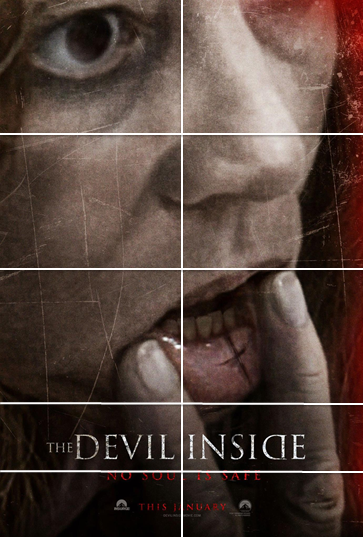The title of ‘The Devil Inside’ immediate communicates to the viewer that this is possessive horror and that the character feature is the object of the possession. The use of the syntax ‘devil’ as opposed to demon means that there is going to be a prominent theme of religion, the audience rightly assumes that this concerns Catholicism, represented by the use of the cross.
The title also goes some way to explain the figure present on the poster. Her vacant eyes suggest that the ‘devil’ that has possessed her is not present and has left her weak. The audience cannot see who she is viewing, the lack of any feeling in her eyes implies that there may not even be anyone there and that there the devil has taken her sanity as well as her body.
Her uses two fingers to spread her bottom lip, revealing a deep scarred shaped as a cross. This could suggest one of a number of things all relating to the church. It could be that the possession has left her so weak that this is her only way of communicating her situation and that her disfigured herself for this reason. The communication may be that her situation is the fault of the church or that inside she is still devout, despite her possession. Another possibility is that the church did this to her in an attempt to banish the devil from her, the healing of the wound implies this is one of many attempts that has failed.
The poster itself appears to be a scratched photograph with the text imposed over it. Low saturation and increased noise on the editing of the key image create the feeling of an aged picture documenting the situation. This may be a primitive form of recorded possessions and exorcism, a theme frequent in modern supernatural horrors. This tells the audience that this issue is recurring and has been going on for very many years, judging from the poor condition of the photograph is may have been smuggled away and is any item that the maker wants to be kept secret.
The title features backwards character, this suggests a use of mirrors is either the cause or solution to the disruption. Films such as ‘Constantine’ have demonstrated a use of mirrors during the exorcism itself in order to trap and therefore defeat possessive demons. Where as other films such as ‘Mirrors’ have showed a more sinister associate with the item where the dead control and hurt the living through the portal of a mirror.
The tagline of ‘No soul is safe’ is short and memorable. This phrase implies that even through the horror may have been contained previously, some event in the film unleashes it and therefore poses a threat to everyone, and this is to scare the audience.
A red glow mingles in with the shadows in the background of the key image of that character’s face. The association with blood suggests that her scarred lip will no be the only wound sustained.
Character more important than text, this is demonstrated by the large proportion of space dedication to the main image and less than a quarter to the title and tagline.
- Meg
- Meg

No comments:
Post a Comment